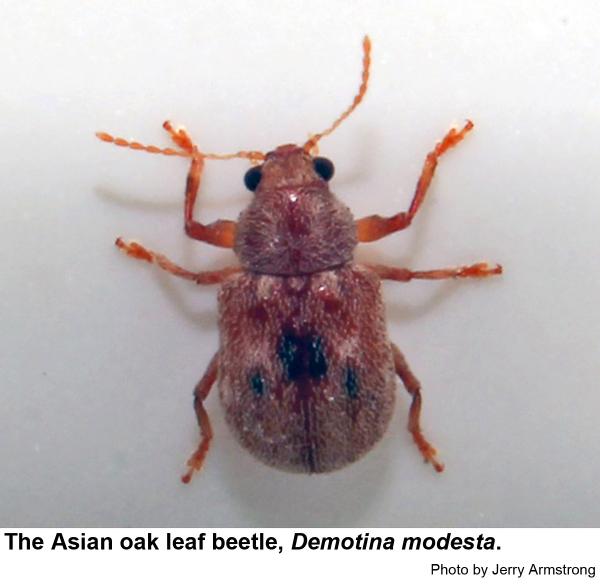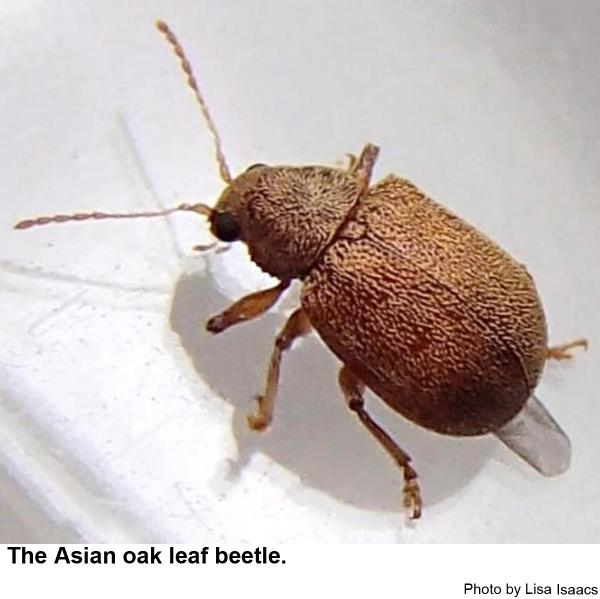Description and Biology
Demotina modesta, is a small (about 1/8 inch long), stocky, brownish leaf beetle. It differs from our many native leaf beetles in that its upper surface is covered with scales just visible through a hand lens. It also differs in that the margins of the pronotum have small teeth along the outer margin. Some specimens have a large, dark, central spot on the wing covers with two smaller spots on each side slightly toward the rear. This Asian species was introduced into the southeastern United States around 1970. It feeds primarily on oaks and could appropriately be called the Asian oak leaf beetle. Demotina modesta is a summer breeder and probably hibernates as larvae or pupae. Evidently without mating (no males have been found), females lay fertile eggs singly on the undersides of leaves and cover the them with excrement. Newly hatched grubs drop down and dig into the soil to feed on roots. The larvae are stocky rootworms with short legs and a somewhat curved abdomen.
Host Plants
The Asian oak leaf beetle can become abundant on oaks as well as the related Japanese Chinquapin, Castanopsis cuspidata. Leaf curl and distortion caused by these beetles seems to be unique among the leaf beetles that feed on oaks.
Residential Recommendations
If the Asian oak leaf beetle becomes a problem, it is most likely to be susceptible to various pyrethroid insecticide labeleds for use in the home landscape such as permethrin, bifenthrin, or lambda cyhalothrin. These pyrethroids are available in most big box store garden supply areas. They are very toxic to fish so avoid contaminating pools, ponds, or streams. Bifenthrin and lambda cyhalothrin are also toxic to spider mites and eriophyid mites. However, prolonged applications of pyrethroids may allow populations of soft scales such as kermes scales or oak lecanium scales to increase dramatically because pyrethroids are toxic to beneficial insects that control soft scale populations. Casey Scarl and Whitney Cranshaw at Colorado State University showed that an application of a systemic insecticide such as imidacloprid (also available for home use) can give season-long control of leaf beetles. However, imidacloprid may enhance spider mite problems. I predict that in any particular landscape should Demotina modesta appear, it will be a noticeable pest for a year or two and then will fade away for years or decades as its diseases and parasites become abundant.
Other Resources
- Differentiation in life history pattern and oviposition behavior, the thelytoky in Demotina and Hyperaxis beetles (Coleoptera, Chrysomelidae) in western Japan. Isono, M. 1988. Japanese Journal of Entomology 56(2): 402-409.
- Eumolpinae – a widely distributed and much diversified subfamily of leaf beetles (Coleoptera, Chrysomelidae). Pierre Jolivet, P and K. K. Verma. 2008. Terrestrial Arthropod Reviews 1 (2008) 3–37.
- Evaluation of New Systemic Insecticides for Elm Insect Pest Control. Sclar, D. C. and W. S. Cranshaw. 1996. Journal of Environmental Horticulture 14(1): 22-26.
- New records, nomenclatural changes, and taxonomic notes for select North American leaf beetles (Coleoptera: Chrysomelidae). Edward G. Riley, E. G., S. M. Clark, and A. J. Gilbert. 2001. Insect Mundi, Vol. 15, No.1, March.
- Extension Plant Pathology Publications and Factsheets
- Horticultural Science Publications
- North Carolina Agricultural Chemicals Manual
For assistance with a specific problem, contact your local N.C. Cooperative Extension Center
This Factsheet has not been peer reviewed.
Publication date: Dec. 10, 2018
Revised: Sept. 13, 2023
Recommendations for the use of agricultural chemicals are included in this publication as a convenience to the reader. The use of brand names and any mention or listing of commercial products or services in this publication does not imply endorsement by NC State University or N.C. A&T State University nor discrimination against similar products or services not mentioned. Individuals who use agricultural chemicals are responsible for ensuring that the intended use complies with current regulations and conforms to the product label. Be sure to obtain current information about usage regulations and examine a current product label before applying any chemical. For assistance, contact your local N.C. Cooperative Extension county center.
N.C. Cooperative Extension prohibits discrimination and harassment regardless of age, color, disability, family and marital status, gender identity, national origin, political beliefs, race, religion, sex (including pregnancy), sexual orientation and veteran status.


